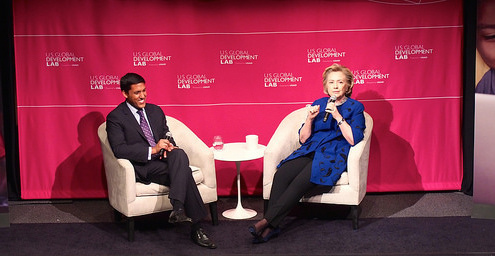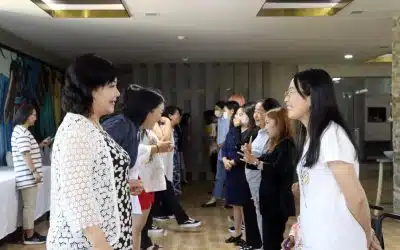InAsia
Insights and Analysis
A Conversation with Dr. Rajiv Shah
April 29, 2015
Recently retired after five years at the helm of USAID, Rajiv Shah brought new energy and improved morale, and earned bipartisan Congressional support as director of the United States’ premier development agency. Shah emphasized measurement, transparency, and outcomes in development spending, and he championed the idea that development dollars should build local institutions within developing countries. He has argued passionately that development policy is an intrinsic part of US foreign policy and national security, and during his tenure USAID gained a seat on the National Security Council. Newly appointed to the Georgetown University School of Foreign Service, Dr. Shah spoke last Thursday to the UC Berkeley Masters of Development Practice program. While he was in town, he sat down for a conversation with In Asia Managing Editor John Rieger.

Rajiv Shah with former U.S. Secretary of State Hillary Clinton at the U.S. Global Development Lab Launch. Photo/Flickr user USAID_Images http://bit.ly/1EAVkFY
Dr. Shah, you recently left USAID, where you were greatly respected on all sides. Looking back, what would you say was your proudest moment there?
Well, I’m particularly proud of the way we tried to elevate development as a bigger part of our foreign policy, from the Haiti earthquake response in my first week on the job, to the fight against Ebola that I think was successfully executed in my last months in more than five years in the role. I think we made development relevant to American foreign policy and national security strategy, and helped millions of people move out of poverty and hunger.
Now you’ve gone to Georgetown. What are you going to do there?
Well, I’m thinking, and writing, and teaching a little bit, with a focus on continuing to learn about how the fight against extreme poverty can be won in the next 10 to 15 years. It’s a very special time in global development, when it’s possible to imagine, in just a decade or so, the end of preventable child death, large-scale child hunger, and extreme human subsistence.
Asia – where The Asia Foundation works – is now experiencing rapid urbanization. What is an appropriate development strategy for rapidly urbanizing areas of Asia?
Well, there’s a very important reality that Asia and many other parts of the world will need more infrastructure – modern, low-carbon, and resilient infrastructure – to manage population growth and to usher in better living standards for a large-scale, emerging middle class. And as Asia urbanizes, building out that infrastructure in a manner that’s efficient and effective is one of the great challenges we all face together from a developmental perspective.
In the past, urbanization has often meant informal settlements, slums, and concentrations of intense poverty. Does urbanization have to be that?
It absolutely does not have to be that. I mean, if we were embarking on a smart, thoughtful infrastructure build-out, you would have adequate public services, cleanliness in terms of public hygiene and sanitation systems, access to modern urban amenities, and you’d create millions of jobs in the process that will help provide a boost to global and Asian growth, and will help to insure that that growth reaches all parts of society and not just the very top.
India is a good example where there is urbanization, but there is also dramatic unevenness. How would you assess India as an emerging development actor? And do you have any specific observations about the prospects for the Modi government?
Well, the Modi government has instilled a new hopefulness about the Indian economy. They will now need to execute on their commitments to improve energy infrastructure and access, to implement the CLEAN-India initiative, and to invest in the infrastructure of thousands of urban environments throughout the country in a way that’s very forward looking. So, India has a chance to be very successful and a major growth pole for the global economy, but it will require real execution against the commitments that the prime minister has made.
Looking ahead, where do you see the United States and USAID focusing its resources and attention in Asia, and what will relations be like with other, emerging development actors, particularly China?
Well, over time, the United States and China should try to come together to improve the way we all do development work around the world. China has been the world’s largest financier of infrastructure, but some of that work has been built out at a lower set of quality standards, and economic practices that have not necessarily helped to reduce poverty as much as we’d like. The United States has a tremendous, six-plus-decade history of being the world’s leader in development and humanitarian affairs, and there should be ample opportunity to come together and do things in a more joint fashion in Asia, in Africa, and other parts of the world.
Just to follow up on that, looking specifically at the Asian Infrastructure Investment Bank, is that a promising organ for international development in the future? Or is it a response to America’s pivot to Asia?
It is, I think, an important potential part of the global system of providing finance to infrastructure needs around the world. The more that a broader range of countries participate with that new institution and insure that it meets the standards of environmental protection and quality implementation, the better off the whole world will be, and certainly the Asian economies that will benefit from grants, loans, and equity investments made by that institution.
A cornerstone of Western development philosophy – transparent, democratic governance and robust civil societies – is intrinsically hard to measure. Some now believe the historical trend towards democracy in Asia has slowed. What’s the best way to support Asian governments in this area where results are so hard to measure?
Well, you know, there are no easy answers. Continued diplomatic engagement to insist upon high standards of democratic process and transparency are always important parts of the equation. Development institutions like USAID and others, I believe, should always invest in civil society organizations in these countries, even when that’s not popular, so that that diversity of thought and the independence of civil society can always be a check on government. Those can be difficult investments to make in highly intense diplomatic environments, but they are important over time: it’s important that our foreign assistance reflects our values.
You ruffled some feathers when you famously remarked that USAID was “no longer satisfied with writing big checks to big contractors and calling it development.” What did you mean? And where do you think an organization like The Asia Foundation fits into the future of US foreign assistance?
Well, I think USAID – and the World Bank and other major developmental institutions – should do its work with the mindset that our goal is to build local capacity and put ourselves out of business over time. When I started, I thought we were overweight on the grants and contracts to US-based contractors, and we should prioritize the building of local capacity. I still think that’s true, and I think The Asia Foundation and others need to do, and often do, an increasingly better job of building local institutions – in civil society, in the business sector, in government – so that someday we can all put ourselves out of business.
(This interview has been edited and condensed for publication.)
About our blog, InAsia
InAsia is posted and distributed every other Wednesday evening, Pacific Time. If you have any questions, please send an email to [email protected].
Contact
For questions about InAsia, or for our cross-post and re-use policy, please send an email to [email protected].The Asia Foundation
465 California St., 9th Floor
San Francisco, CA 94104
The Latest Across Asia
Program Snapshot
April 18, 2024
News
April 17, 2024

2024 Lotus Leadership Awards
Thursday, April 25, 2024, New York City
The Lotus Leadership Awards recognize contributions towards gender equality in Asia and the Pacific







0 Comments